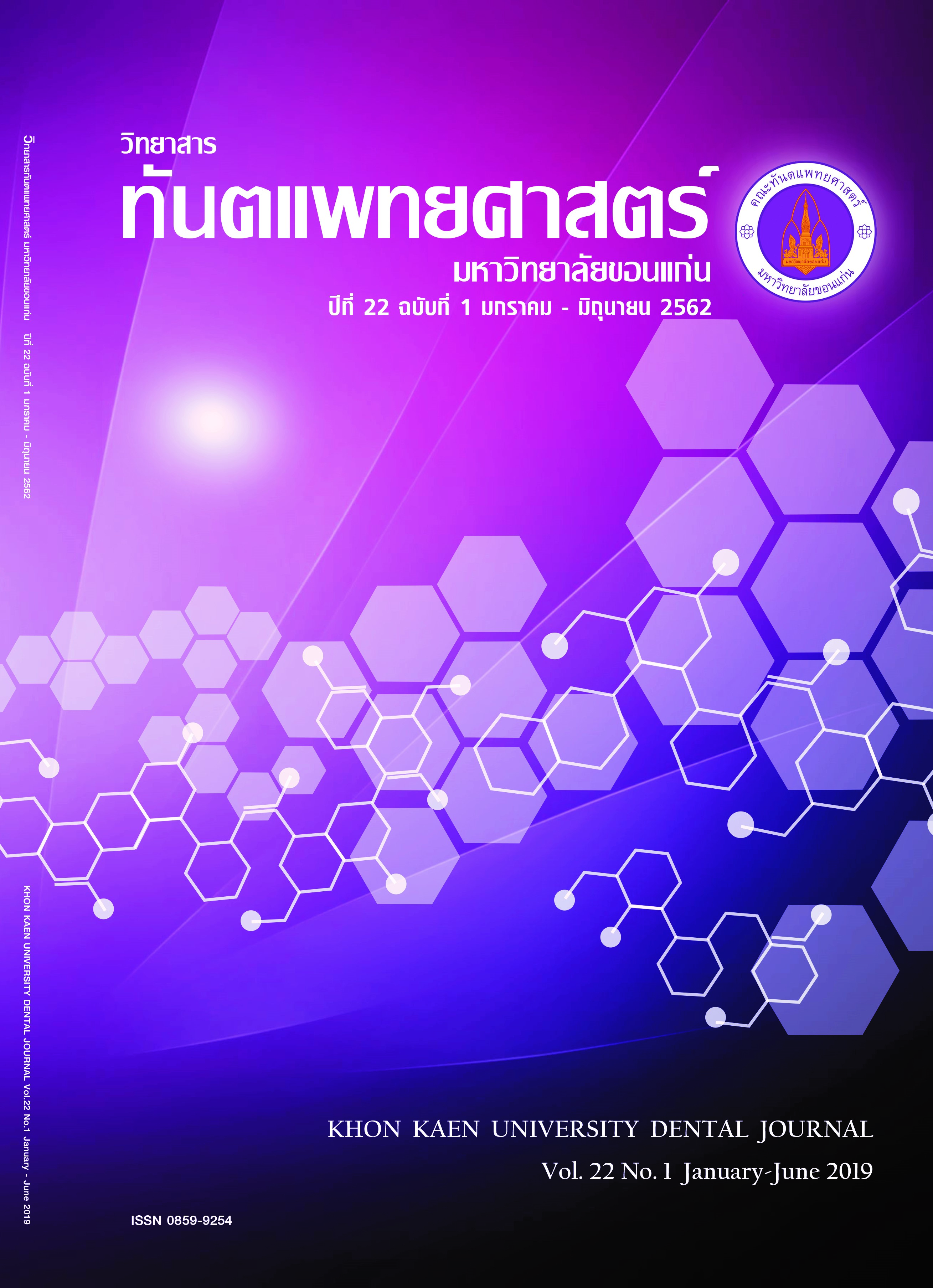Inhibitory Effects of Date Fruit (Pheonix dactylifera L.) Extracts on Oral Cancer Cell Lines
Main Article Content
Abstract
Date fruit (Phoenix dactylifera L.) has been known as a fruit with richness of nutrients, dietary fiber, essential minerals and vitamin contents. Previous studies reported that date fruit provided a variety of health benefits. Over the past five years, date palms have been cultivated throughout the north-eastern regions of Thailand, and date fruit becomes popular for Thai people. However, very limited data of date fruit in association with oral health benefits are available. The purpose of this study was to determine the effects of date fruit extracts on oral cancer cell lines. Date fruits derived from three stages including Kimri; Khalal; and Rutab were prepared for crude extraction by ethanol. Two oral cancer cell lines (ORL-48T and ORL-136T) were used in this study. Primary oral epithelial cells isolated from gingival tissue were used as control. Cell cytotoxicity and cell viability were determined by MTT assay. DPPH assay was used to evaluate the antioxidant activity in date fruit extracts. According to analyzing chemical compositions, phenolic compounds and flavonoids were the essential components in date fruit extracts. According to MTT assays, date fruit extracts from three stages had inhibitory effects on two oral cancer cell lines, as compared with normal oral epithelial cells (p-value<0.05). The crude extracts from Khalal stage demonstrated the best inhibitory effect on reduction of oral cancer cell growth. In conclusion, the present study provides new evidence of inhibitory effects of date fruit extracts on oral cancer cell lines. These findings imply clinical use of date fruit extracts for oral health benefits.
Article Details
บทความ ข้อมูล เนื้อหา รูปภาพ ฯลฯ ที่ได้รับการลงตีพิมพ์ในวิทยาสารทันตแพทยศาสตร์ มหาวิทยาลัยขอนแก่นถือเป็นลิขสิทธิ์เฉพาะของคณะทันตแพทยศาสตร์ มหาวิทยาลัยขอนแก่น หากบุคคลหรือหน่วยงานใดต้องการนำทั้งหมดหรือส่วนหนึ่งส่วนใดไปเผยแพร่ต่อหรือเพื่อกระทำการใด ๆ จะต้องได้รับอนุญาตเป็นลายลักษณ์อักษร จากคณะทันตแพทยศาสตร์ มหาวิทยาลัยขอนแก่นก่อนเท่านั้น
References
Tang ZX, Shi LE, Aleid SM. Date fruit: chemical composition, nutritional and medicinal values, products. Journal of the science of food and agriculture 2013;93(10):2351-61.
Karasawa K, Uzuhashi Y, Hirota M, Otani H. A matured fruit extract of date palm tree (Phoenix dactylifera L.) stimulates the cellular immune system in mice. Journal of agricultural and food chemistry 2011;59(20):11287-93.
Al-Farsi M AC, Morris A, Baron M and Shahidi F. Comparison of antioxidant activity, anthocyanins, carotenoids, and phenolics of three native fresh and sun-dried date (Phoenix dactylifera L.) varieties grown in Oman. Agric Food Chem 2005;53:7592–9.
Al-Shahib W, Marshall RJ. The fruit of the date palm: its possible use as the best food for the future? International journal of food sciences and nutrition 2003;54(4):247-59.
VAYALIL PK. Antioxidant and Antimutagenic Properties of Aqueous Extract of Date Fruit (Phoenix dactylifera L. Arecaceae). agricultural and food chemistry 2002;50:610-7.
Sallal AK, Ashkenani A. Effect of date extract on growth and spore germination of Bacillus subtilis. Microbios. 1989;59(240-241):203-10.
Ishurd O, Kennedy JF. The anti-cancer activity of polysaccharide prepared from Libyan dates (Phoenix dactylifera L.). Carbohydrate Polymers 2005;59(4):531-5.
Khan F, Ahmed F, Pushparaj PN, Abuzenadah A, Kumosani T, Barbour E, et al. Ajwa Date (Phoenix dactylifera L.) Extract Inhibits Human Breast Adenocarcinoma (MCF7) Cells In Vitro by Inducing Apoptosis and Cell Cycle Arrest. PloS one 2016;11(7):e0158963.
Folin O. On tyrosine and tryptophan determinations in proteins. J Biol Chem 1927;73:627-49.
Chang CC, Yang MH, Wen HM, Chern JC. Estimation of Total Flavonoid Content in Propolis by Two Complementary Colorimetric Methods. Journal of Food and Drug Analysis 2002;10(3):178-82.
Chu YH, Chang CL, Hsu HF. Flavonoid content of several vegetables and their antioxidant activity. Journal of the Science of Food and Agriculture 2000;80(5):561-566.
Mosmann T. Rapid colorimetric assay for cellular growth and survival: application to proliferation and cytotoxicity assays. Journal of immunological methods 1983;65(1-2):55-63.
Khan A, Chen H-c, Tania M, Zhang D-z. Anticancer Activities of Nigella Sativa (Black Cumin). African Journal of Traditional, Complementary, and Alternative Medicines 2011;8(5 Suppl):226-32.
Lee G, Kim YB, Kim JH, Kim MS, Shin KH, Won YS, et al. Characterization of novel cell lines established from three human oral squamous cell carcinomas. International journal of oncology 2002;20(6):1151-9.
Anantharaju PG, Gowda PC, Vimalambike MG, Madhunapantula SV. An overview on the role of dietary phenolics for the treatment of cancers. Nutrition Journal 2016;15:99.


